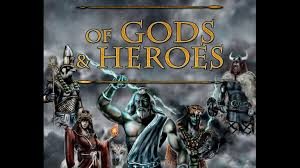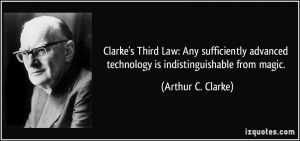I missed my regular post last week as I was away on one of my gaming weekends. This time I got to play my 1st level Lay Healer as well as GM my Forgotten Realms game.
I have been accelerating my players progress so far and this time at the en dof th esession they finally broke 5th level. This is where I wanted them to be and now the game starts to get serious.
There were a few interesting things that came up over the weekend.
Firstly is the sequence of dice rolls in this posts title. I really, really try not to fudge dice rolls. roll in the open and my players know that.
Any weapon, in any combat those three numbers you really do not want to come up in that order. That was the one and only contribution to a combat by my Hobgoblin chieftain with his ‘trusty’ scimitar. You can work out for your self what happened to him.
I have been working on pushing the limits of how big a force you can throw against low level characters before the sheer number of random rolls will overwhelm them. If you have twenty archers then the odds are that one will get an open ended every single round (I haven’t done this, it is just an example).
The party were making their way up a single track goat trail into a mountain range. They were approaching the tree line when up ahead they could see a flock of monstrously large birds dive bombing something out of sight. The elves in the part could see the birds taking to the air again with dripping lumps of meat in their talons and eat rising bird was being mobbed by the other members of the flock. One character has no maths skill at all so for him there where ‘a great many’ birds. The other elf was better educated and put the number between 70 to 80 individuals.
The creatures were Gorcrows and I had used them to replace the Stirges specified in the original D&D module that was the backbone of the adventure. The birds were feeding on some horses that they had killed. The horses were an important clue for the players as they were looking for a lost patrol and these were their horses.
I wasn’t going to throw 75 beasties at the party in a single shot. I had a few Gorcrows spot the party and break away. This gave me 15 to play with against 5 characters. The birds circled a bit like your classic vulture and then first few peeled away to dive into the attack. These first few were dealt with using a sleep spell. This gave the party some confidence that they could tackle them. The next wave was 5 or 6 gorcrows and a combination of sleep spells and thrown weapons brought them crashing to the ground. Finally the third wave of 7 dived down to attack, too many to sleep even when fast casting without prep. A few got through the barrage of magic and thrown weapons but the birds didn’t stand a chance. A few hits of damage were done here and there a single A crit.
The fight and scent of fresh blood had attracted the attention of the main flock. As the party saw the cloud of birds turn into a stream angling towards them you have never seen players evaluate their options so quickly!
The used what cover they could find to hide them selves from the birds (who fell upon their fallen comrades) and made their way into the next valley where they had their first encounter with wild magic. This is not too dissimilar to an Essence storm.
Wild magic can produce a great number of different effects and have different manifestations. This particular one was very large and actually covered the entire area that the main adventure was going to take place in, several square miles of mountain range. At the first encounter all they got was tingling feelings and hairs standing up on their arms or the back of the neck but as they continued they saw the full scale of the anomaly. In game terms they started to recover power points almost by the minute. The further in they got the more power they regained. It was only when they tried to cast a spell that things were not so good. Every spell cost no power to cast but it did deliver a Stress critical equal to the spell level (1st = A, 5th = E and a 6th would have been an A + E critical).
As a GM my objective was to make the players seriously consider each and every spell they cast. It certainly did that.
The adventure I was basing the session on had two major features, the first was a terrible D&D style trap that had no connection the time or place that the adventure took place in and a collection of monsters.
The monsters were supposedly in a sealed tomb that had not been disturbed for 300 years before a landslide revealed the entrance. The doors were magically sealed so no monsters could wander in from outside.
I removed everything that should have starved to death. This left just one encounter that the players fully understood and chose not to engage in. As it was with magic doing as much harm to them as to anyone they were attacking that was probably the right answer.
I was worried that this would be an anti climax but actually the players enjoyed a relatively easy win for a change and a nice clean “we had a task and we completed it” session.
The next encounter was another mass battle. one thing had lead to another and the players know they have to meet someone in a monster infested forest. Everyone one knows this is a monster infested forest and the party are well armed and provisioned.
We had the players trying to ambush and war band of goblins and hobgoblins while they [the goblins] were trying to set up an ambush. The goblins spotted the party so decided to set an ambush. So the party were trying to sneak into position when the goblins got the drop on them.
I had about 30 goblins to play with but I decided the chief would not commit his entire force against just 5 travellers. So 12 of his toughest attacked the party. The party reverted to type again and sleep spells flew about willy nilly accounting for over half the attackers. Once melee was engaged the superior level of the party soon took its toll on the goblins.
I then allowed the party to turn the tables on goblins. The odds were 18 to 5 or more realistically 18 to 4 as one of the party is a non combatant. The result was again more goblin mince meat.
All of these mass battles were really won by the parties use of sleep. They have two casters who can cast up to Sleep VII. In addition the party are now feeling more confident in their own abilities and starting to work more effectively as a team.
The party are all now 5th level and I think at this point they are growing into their strengths, the sorcerer is starting to diverge from the warrior mage who is diverging from the elemental warrior and so on.
Next time though they will need to find a new tactic as the monsters will be getting significantly tougher!









